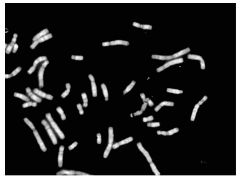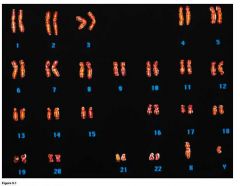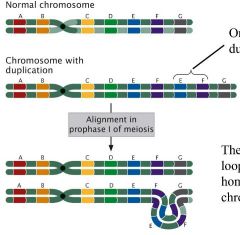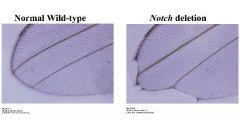![]()
![]()
![]()
Use LEFT and RIGHT arrow keys to navigate between flashcards;
Use UP and DOWN arrow keys to flip the card;
H to show hint;
A reads text to speech;
56 Cards in this Set
- Front
- Back
|
Chromosomes |
-Large piece of DNA -DNA double helix structure -can have a single chromatid or two sister chromatids |
|
|
Telomeres |
Stable ends of the chromosomes |
|
|
Centromere |
Constricted region of the chromosome where the kinetochore forms and the spindle microtubules attach |
|
|
Metacentric |
the centromere is located approximately in the middle, and so the chromosome has two arms of equal length |
|
|
Submetacentric |
the centromere is located approximately in the middle, and so the chromosome has two arms of equal length |
|
|
Acrocentric |
the centromere is near one end, producing a long arm and a knob,or satellite, at the other |
|
|
Telocentric |
the centromere is at or very near the end of the chromosome |
|
|
Phytohemagglutinin |
-Mitogen -Stimulates mitosis |
|
|
Colchicine |
-Disables the spindles |
|
|
Colchicine |
-Disables the mitotic spindles |
|

|
Q Banding Quinacrine Mustard Fluorescent |
|

|
C Banding Centromeric Heterochromatin |
|

|
R Banding GC rich regions |
|
|
Aneuploidy |
the presence of an abnormal number of chromosomes in a cell, such as having 45 or 47 chromosomes when 46 is expected |
|
|
Polyploidy |
Cell containing more than two paired (homologous) sets of chromosomes |
|
|
Change in chromosome structure can result in different phenotypes becasue: |
-changes in gene number (dosage) -changes in gene position (chromatin) -disruption of coding sequences |
|
|
In animals, including humans, rearrangements particularly _________ and __________ are often lethal and almost always deleterious. |
Deletions and duplications |
|
|
Chromosomal rearrangements occur primarily as a result of: |
Illegitimate recombination or breakage- joining (nonhomologous end joining) |
|
|
Rearrangements can occur in: |
Both mitosis and meiosis (mitotic can result in mosaics) |
|
|
Chromosomal mutations can arise in _______A________ of ______B_______. In order to be passed on the mutation must be in ______C______. |
A) in any cell B) any tissue C) germinal tissue |
|
|
Duplication |
Type of mutation. Segment of the chromosome is duplicated. |
|
|
Deletion |
Type of mutation. Segment of the chromosome is deleted. |
|
|
Inversion |
Type of mutation. Segment of the chromosome becomes inverted, turned 180°. |
|
|
Translocation |
Type of mutation. Segment of the chromosome moves from one chromosome to a non-homologous chromosome or to another place on the same chromosome. |
|
|
In an individual heterozygous for a duplication, the duplicated chromosome ____A____ during ___B___ of ____C____ in ____D_____. |

A) loops out B) synapsis C) homologous pairing D) prophase I |
|
|
The Bar phenotype in Drosophila results from ____A____. Unequal crossing over produces ____B___ and _____C_____ mutations. Chromosomes do not align properly resulting in unequal crossing over: one chromosome has a ____D_____ and the other ______E_____. |
A) An X-linked duplication B) Bar C) double Bar D) Bar duplication E) deletion |
|
|
Unbalanced gene dosage leads to developmental abnormalities. Duplications and other chromosome mutations produce ____A____ of ______B_______ which alters the relative amounts (doses) of ______C______. If the amount of one product ____D____ but the other product _____E____ developmental problems occur. |
A) extra copies B) some but not all genes C) interacting gene products D) increases E) remains the same |
|
|
Interstitial deletion |
Chromosomal deletion. Result of two breaks. |
|
|
Terminal deletion |
Chromosomal deletion. Result of a single break. |
|
|
Intragenic deletion |
Chromosomal deletion. A small deletion within the gene. |
|
|
Multigenic deletion |
Chromosomal deletion. Large deletion involving two to several thousand genes. |
|
|
Chromosomal deletions are recognized by: |
-reduced recombination frequency -pseudodominance -recessive lethality -lack of reverse mutation -visible deletions |
|
|
Chromosomal deletion result in _____A_____. Phenotypic consequences of a deletion depends on _____B_____. If a deletion includes the ____C____, the chromosome will not segregate in mitosis or meiosis and will usually be lost. |
A) looping similar to duplication B) the genes located in the deleted region C) centromere |
|
|
Many deletions are ____D____ in the homozygous state because all copies of any ____E____ location in the ____F_____ are missing. |
D) lethal E) essential genes F) deleted region |
|
|
Heterozygous individuals for deletions may have multiple defects for 3 reasons: 1) the heterozygous conditions may produce an __A__ in the amount of __B__ similar to the __C__ produced by __D__. |
A) imbalance B) gene products C) imbalance D) extra gene copies |
|
|
Heterozygous individuals for deletions may have multiple defects for 3 reasons: 2) recessive mutations on the ____E____ lacking the deletion may be expressed when the ____F____ allele has been ____G____ (pseudodominance). |
E) homologous chromosome F) wild type G) deleted |
|
|
Heterozygous individuals for deletions may have multiple defects for 3 reasons: 3) some genes must be present in ___H___ copies for normal function. When a single copy gene is not sufficient to produce a ___I____ (haploinsufficient gene) loss of function mutations in ____J_____ are ____K_____. |
H) two I) wild type phenotype J) haploinsufficient genes K) dominant |
|
|
The Notch phenotype is produced by a ___A___ that includes the __B__ gene. The Notch locus is __C__. |

A) chromosomal deletion B) Notch C) haploinsufficient |
|
|
A chromosomal inversion occurs where a chromosome segment is __A__. The is believed to happen when chromosome __B__ occur. The __C__ piece may reattach but not necessarily in the same __D__as before. |
A) inverted (turned 180°) B) breaks C) broken D) orientation |
|
|
Which chromosomes are inverted? Names? ●=centromere 1) AB●CDEFG 2) AB●CFEDG 3) AD●CBEFG |
1) normal chromosome 2) inverted: paracentric 3) inverted: pericentric |
|
|
In chromosome inversion, no __A__ of genetic material, only order has been __B__. Inversion may break __C__ into 2 parts. |
A) loss or gain B) altered C) gene |
|
|
Position effect |
The position of many genes on chromosome effects their regulation. Inversion can cause inappropriate expression patterns. |
|
|
In chromosomal inversions the heterozygote has one __A__ chromosome and one chromosome with an __B__ segment. (Paracentric) |
A) normal B) inverted |
|
|
In prophase I ofmeiosis, thechromosomes form an ____A____, whichallows the homologoussequences to align. This paracentric loop structure is one way to detect ___B____. |
A) inversion loop B) inversions |
|
|
Crossing Over within aParacentric Inversion The heterozygote possessesone wild-type chromosomeand one chromosome with a ____A___. In prophase I, an ___B___ forms. A single crossover withinthe inverted region resultsin an ___C___ structure. |
A) paracentric inversion B) inversion loop C) unusual |
|
|
Crossing Over within aParacentric Inversion One of the four chromatidsnow has two ___D___ and one lacks a centromere. The cell then enters ___E___. In anaphase I, the centromeres separate,stretching the ___F___ chromatid, whichbreaks. The chromosome lacking a centrosome is __G__. |
D) centromeres F) dicentric G) lost |
|
|
Crossing Over within aParacentric Inversion In anaphase II, four __H__ are produced. Two gametes contain wild-type __I__ chromosomes. The other two contain __ J__ chromosomes that are missing somegenes; these gametes will not produceviable offspring. |
H) gametes I) nonrecombinant |
|
|
Crossing Over within aPericentric Inversion Recombination is also reduced within a pericentricinversion. No __A__ or __B__ areproduced, but recombinant chromosomes have toomany copies of some genes and no copies of others. Gametes that receive __C__ cannot produce viable progeny. |
A) dicentric bridges B) acentric fragments |
|
|
Crossing Over within aPericentric Inversion The heterozygote possessesone __D__ chromosomeand one chromosome with a __E__. In prophase I, an __F__ forms.A single crossover withinthe inverted region resultsin an __G__ structure. |
D) wild-type E) pericentric inversion F) inversion loop G) unusual |
|
|
Crossing Over within aPericentric Inversion If crossing over takes place withinthe inverted region, two of theresulting chromatids will have __H__ copies of some genes and __I__ of others. The chromosomes separate in __J__. The chromatids separate in __K__ forming four gametes. |
H)too many |
|
|
Inversions In heterozygotes, inverted region loops out whenhomologous chromosomes __A__ in meiosis I. Can have phenotypic effects– may __B__ in two– may have __C__. Observed recombination is reduced because of theproduction of __D__ gametes. |
A)pair |
|
|
Translocation |
entails the movement of genetic materialbetween nonhomologous chromosomes or within the samechromosome. Should not be confused with crossing over. |
|
|
Crossing Over |
The exchange of genetic material between homologouschromosomes |
|
|
Nonreciprocal translocation |
AB-CDEFG and MN-OPQRS----> AB-CDG and MN-OPEFQRS |
|
|
Reciprocal Translocation |
AB-CDEFG and MN-OPQRS ----->AB-CDQRG and MN-OPEFS |
|
|
|
|

